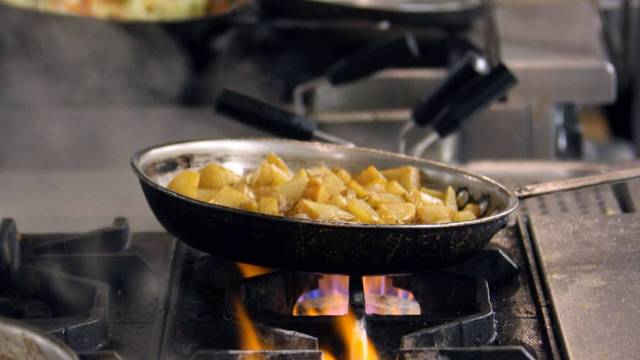Savor Authentic Eastern Cuisine With a Pan-Asian Twist for a Cooking Adventure
Beginning on a culinary trip via genuine Oriental cuisine, improved with a Pan-Asian spin, supplies an unique opportunity to discover the abundant tapestry of flavors that specify the region's diverse culinary traditions. This experience welcomes you to appreciate the elegant balance of tastes-- pleasant, salted, spicy, and sour-- harmonized by fragrant herbs and spices. Imagine the innovative fusion of Thai curry and ramen or the unanticipated joy of sushi burritos. As you consider these attracting recipes, think about the cultural stories and historical influences that shape them, each bite offering a tale waiting to be discovered.
Exploring Pan-Asian Flavors
In the world of worldwide gastronomy, Pan-Asian food stands out for its exceptional variety and the unified interplay of tastes from various Oriental societies. This culinary method commemorates the rich customs and unique components located throughout the continent, creating a tapestry of tastes that is both fascinating and gratifying. Secret to Pan-Asian food is its capacity to balance contrasting flavors-- wonderful, salty, spicy, and sour-- while highlighting the quality and top quality of each ingredient.
From the umami-rich soy sauce of Japan to the fiery chili peppers of Thailand, Pan-Asian cuisine offers a comprehensive scheme of flavors. These aspects are usually integrated in inventive ways, enhancing dishes with layers of intricacy. For example, the use of great smelling natural herbs such as lemongrass and cilantro, typical in Vietnamese and Thai food, adds a refreshing brightness to dishes, while the unification of coconut milk delivers a creamy, abundant structure.
The emphasis on fresh fruit and vegetables and fragrant seasonings ensures that each meal is not just a feast for the palate but also for the detects. Pan-Asian cuisine invites diners to embark on a cooking journey, exploring the substantial and varied landscapes of Asian gastronomy with every bite.
Fusion Recipes to Attempt
While Pan-Asian food is commemorated for its traditional flavors, the modern-day cooking landscape is increasingly accepting blend recipes that blend these classic components with impacts from other regions. This ingenious approach not only honors the rich heritage of Eastern cooking arts but likewise introduces unique preference experiences that appeal to contemporary palates.
A prime instance of such a combination dish is the Korean-Mexican taco, where marinaded bulgogi beef is wrapped in a cozy tortilla, covered with kimchi and a spicy gochujang-infused salsa. This combination marries the vibrant, savory flavors of Korea with the lively, fresh aspects of Mexican food. In a similar way, sushi burritos have acquired popularity, integrating the delicate creativity of Japanese sushi with the hearty, hand-held ease of a burrito, commonly including blend active ingredients like tempura shrimp and avocado with a drizzle of wasabi mayo.
One more notable meal is Thai curry ramen, which instills the creamy, aromatic spices of Thai curry into the comforting broth of standard Japanese ramen, developing an unified blend that entices the senses. These combination meals prolong beyond simple uniqueness; they stand for a cooking discussion between societies, encouraging exploration and innovation on the planet of Pan-Asian food.
Vital Active Ingredients and Seasonings
To really appreciate Pan-Asian cuisine, one must recognize the necessary active ingredients and seasonings that form its structure. This diverse culinary design attracts from a rich tapestry of Asian practices, using a harmonious blend of flavors and textures.
Aromatic aspects are crucial, with garlic, lemongrass, and ginger being ubiquitous throughout different Pan-Asian dishes. These active ingredients provide an aromatic base that boosts the complexity of flavors. Flavors such as celebrity anise, cardamom, and cinnamon present warmth and personality, resembling influences from areas like China and India.

Food Preparation Strategies and Tips
Grasping the art of Pan-Asian food needs familiarity with its distinct food preparation techniques, each adding to the lively tapestry of flavors this cooking practice is commemorated for. Central to these methods is the stir-fry, a rapid cooking method that protects the nutritional integrity and vibrant colors of active ingredients. Making use of a frying pan, the stir-fry technique enables also warmth circulation, crucial for accomplishing the characteristic appearance and taste balance of Pan-Asian dishes.
One more essential technique is steaming, specifically common in Chinese food. This mild technique maintains the all-natural flavors and nutrients of ingredients, making it perfect for fish and shellfish and vegetables. Dumplings, a cherished staple, usually benefit from steaming, resulting in soft, succulent appearances.
Cooking, also indispensable, presents smoky depths to recipes such as Oriental bulgogi or Japanese yakitori (Instagrammable restaurants Islamabad). This method frequently includes marinading components, allowing tastes to permeate deeply prior to food preparation over an open flame or warm plate
Finally, understanding the art of stabilizing flavors-- wonderful, sour, salted, bitter, and umami-- is vital. Properly layering these aspects can elevate a recipe from ordinary to remarkable, providing a facility and satisfying culinary experience that symbolizes the significance of Pan-Asian food.
Dining Experiences Worldwide
Throughout the world, Pan-Asian cuisine supplies an unequaled dining experience, commemorated for its rich tapestry of flavors and dynamic discussions. This culinary phenomenon has actually gone beyond cultural borders, capturing the hearts and tastes buds of food enthusiasts worldwide. In worldwide cities like New York, London, and Sydney, Pan-Asian restaurants serve as melting pots where culinary traditions from Thailand, Japan, China, and past merge, supplying diners with a diverse mix of meals that highlight the area's variety.
The international charm of Pan-Asian cuisine hinges on its capacity to use both credibility and technology. Cooks skillfully marry conventional components such as lemongrass, soy sauce, and miso with contemporary techniques, leading to recipes that are both familiar and refreshingly new. This combination allows diners to start a cooking journey that values heritage while welcoming modernity.
Moreover, eating experiences are elevated via thoughtfully designed atmospheres that reflect the principles of Pan-Asian aesthetic appeals. From minimal Japanese-inspired interiors to lively Thai-themed spaces, each dining establishment provides a special setting that enhances the cooking offerings. Therefore, clients are not simply eating a meal however partaking in a cultural experience, making Pan-Asian eating a truly global phenomenon.
Conclusion
The exploration of Pan-Asian cuisine offers a profound understanding of the elaborate interplay of tastes and cooking traditions throughout Asia. By embracing fusion recipes such as Thai curry ramen and sushi burritos, the cooking journey not just highlights the versatility of traditional components but also showcases ingenious modern methods. This gastronomic adventure, enhanced by crucial seasonings and cooking techniques, supplies an unique chance to value the cultural variety and cooking artistry that specify Pan-Asian food on an international scale.
Getting started on a culinary trip through genuine Asian cuisine, improved with a Pan-Asian twist, provides an one-of-a-kind chance to explore the rich tapestry of flavors that specify the area's diverse culinary practices.In the world of international gastronomy, Pan-Asian cuisine stands out for its remarkable diversity and the unified interaction of tastes from different Asian societies. Key to Pan-Asian cuisine is its capability to balance different tastes-- pleasant, salty, spicy, and sour-- asian fusion restaurant while highlighting the quality and top quality of each active ingredient.
